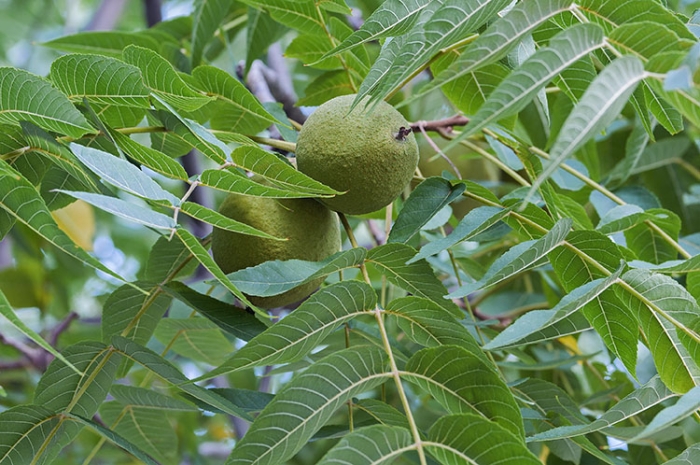Eastern Black Walnut
(Juglans nigra)
Eastern Black Walnut (Juglans nigra)
/
/

Dr. Nick V. Kurzenko
Public Domain
Image By:
Dr. Nick V. Kurzenko
Recorded By:
Copyright:
Public Domain
Copyright Notice:
Photo by: Dr. Nick V. Kurzenko | License Type: Public Domain | License URL: http://creativecommons.org/licenses/publicdomain/ | Attribution: 2015 Nick Kurzenko | Publisher: Calphotos |






































































































Estimated Native Range
Summary
Juglans nigra, commonly known as Eastern Black Walnut, is a deciduous tree native to the deciduous forests of eastern North America, from southern Ontario west to southeast South Dakota, south to Georgia, northern Florida, and southwest to central Texas. It typically grows to a height of 100 feet and a width of 75-100 feet. The tree is known for its strong, deeply furrowed bark and large, pinnate leaves. The flowers are small and yellow-green, appearing in late spring, with male flowers in drooping catkins and female flowers in short spikes. The fruit is a notable large, round, brown nut encased in a thick, green husk.
Eastern Black Walnut is valued for its high-quality timber and the nuts it produces, which are used both culinarily and medicinally. It is often planted as a shade tree in large landscapes and is also used in reforestation projects. The tree prefers deep, fertile, well-drained soils and full sun but can tolerate a range of soil conditions. It is drought-tolerant once established. Gardeners should be aware that the roots, leaves, and nuts contain juglone, a chemical that can be toxic to other plants, making it difficult to grow sensitive species nearby.CC BY-SA 4.0
Eastern Black Walnut is valued for its high-quality timber and the nuts it produces, which are used both culinarily and medicinally. It is often planted as a shade tree in large landscapes and is also used in reforestation projects. The tree prefers deep, fertile, well-drained soils and full sun but can tolerate a range of soil conditions. It is drought-tolerant once established. Gardeners should be aware that the roots, leaves, and nuts contain juglone, a chemical that can be toxic to other plants, making it difficult to grow sensitive species nearby.CC BY-SA 4.0
Plant Description
- Plant Type: Tree
- Height: 75-100 feet
- Width: 75-150 feet
- Growth Rate: Rapid
- Flower Color: N/A
- Flowering Season: Spring
- Leaf Retention: Deciduous
Growth Requirements
- Sun: Full Sun
- Water: Medium
- Drainage: Medium, Fast
Common Uses
Bee Garden, Bird Garden, Butterfly Garden, Deer Resistant, Drought Tolerant, Edible*Disclaimer: Easyscape's listed plant edibility is for informational use. Always verify the safety and proper identification of any plant before consumption., Erosion Control, Fragrant, Rabbit Resistant
Natural Habitat
Deciduous forests of eastern North America
Other Names
Common Names: Eastern American Black Walnut, American Walnut, Noyer Noir, Schwarznuss, Svart Valnöt
Scientific Names: , Juglans nigra, Wallia nigra, Juglans nigra f. nigra, Juglans nigra f. oblonga, Juglans nigra var. oblonga, Juglans pitteursii, Juglans rugosa,
GBIF Accepted Name: Juglans nigra L.